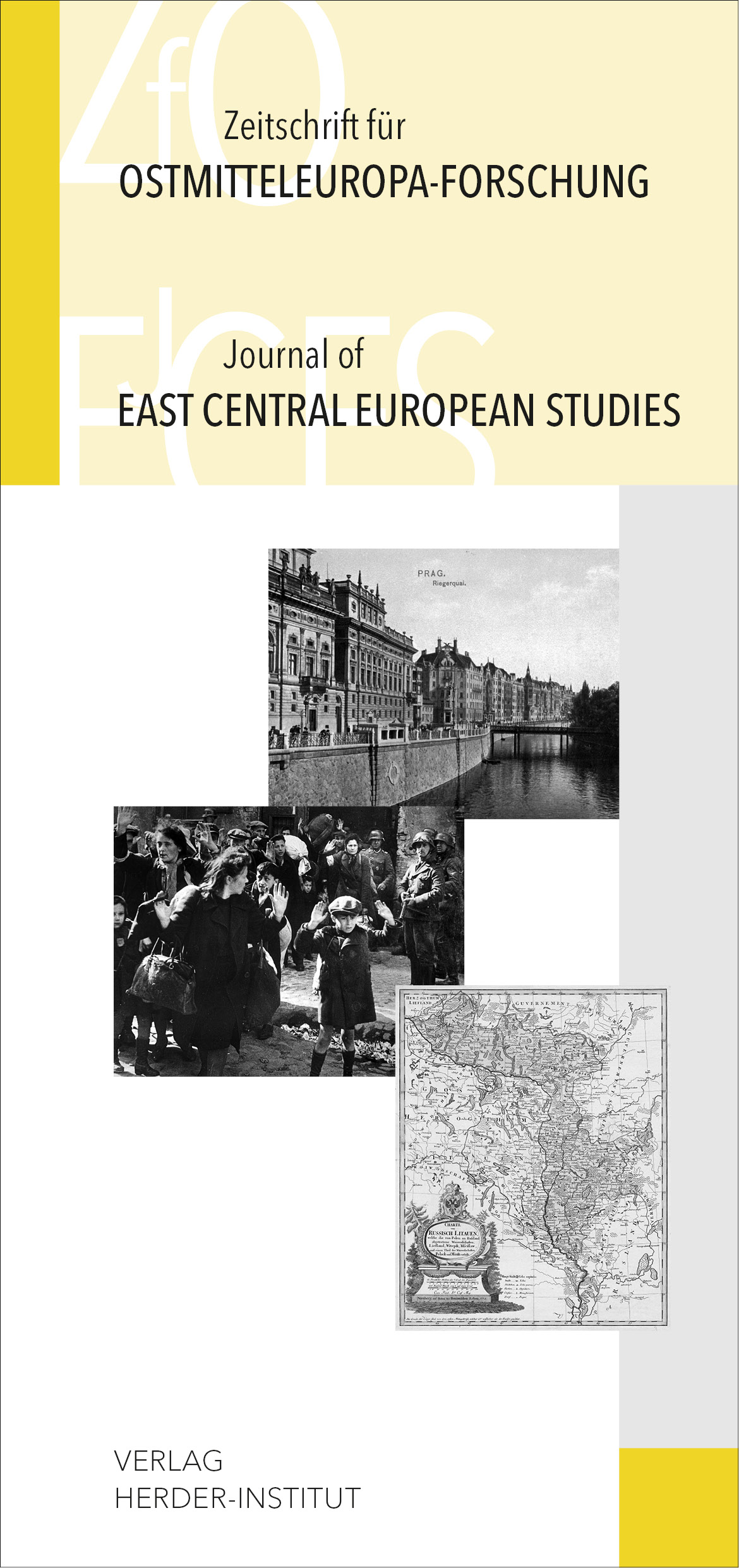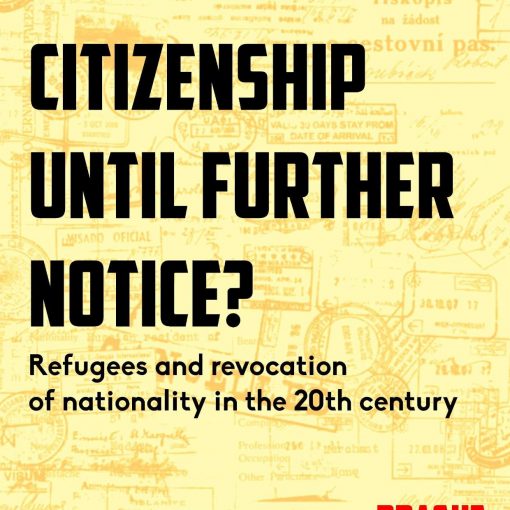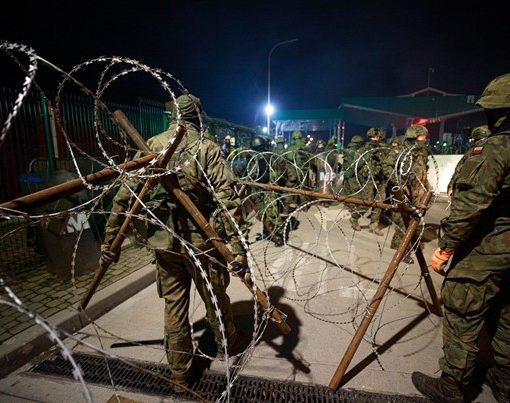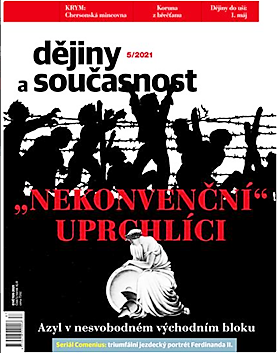
The Unlikely Refuge? (UnRef) team members contributed to the thematical issue of the Journal of East Central European Studies (ZfO/JECES), Vol. 71 No. 4 (2022), entitled East Central Europe as a Place of Refuge in the Twentieth Century: State and Patterns of Historical Research. The individual contributions can be accessed here.
The principal investigator of the UnRef project Michal Frankl authored the introduction to the special issue where he outlines the common aim: “This thematic issue examines, through the eyes of historiography, East Central Europe as a place of refuge. It focuses on a region which has seldom been perceived and researched, at least not on a systematic basis, as a space in which individuals sought protection from persecution and war. More frequently, it has been discussed, in historiography or different forms of public history, as a source of emigration.” Despite that, he argues, “Refugees were an important, and underestimated, part of the history of East Central Europe in the twentieth century.” Frankl outlines some of the commonalities and challenges related to the research of refugeedom in this region, such as the methodology of mapping the state of the field, unstable terminology, methodological nationalism, hegemonic narratives, and sets out the research agenda.
The individual contributions follow the nation-state division of the existing historiographical research.
Ágnes Katalin Kelemen: Refugees and the “Other Hungary”: The Historiography of the Reception of Refugees in Twentieth-Century Hungary
This article surveys the historiography on refugees in twentieth-century Hungary (both works written by Hungarian and foreign researchers) to provide a critical overview of “refugeedom” in the Hungarian context. It identifies a need for future works on the topic to deal with conceptual history. The country’s twentieth-century history is divided into four parts for the purposes of studying the history of refugees: World War I and its aftermath until World War II; the escape from Nazism; the period of state socialism; and the period of transition to democracy. Within the Hungarian-language historiography, research on refugees has tended to support a positive national narrative in which Hungary has repeatedly functioned as a shelter for people who had to escape from somewhere due to real or feared persecution. As far as the two World Wars and the interwar period are concerned, historians pay attention to refugees and connect their reception to the grand questions of those periods (the origin of the interwar period’s antisemitism, Hungary’s relationship with the Third Reich). When it comes to the Cold War and the post-socialist era, however, research on refugee history is dominated by sociologists. This article argues that the refugee history of the Cold War period has remained marginal in historical works due to a widespread insistence on a link between migration and ethnicity that prevents researchers from giving as much attention to political refugees as to refugees who suffered persecution on account of their ethnicity or nationality.
Lidia Zessin-Jurek: Poland, a Country of Refuge? Revisiting the Historiography on Patterns of Migration
Rather than regarding Poland as a shelter for refugees, academicscholars have generally imagined the country as one that produced refugee flows. Even though most Poles believe their nation to be hospitable and tolerant, and to have long provided religious minorities with a safe retreat, historians have not reflected with much sophistication on the accommodation of refugees in more recent Polish history. This essay not only offers a critical overview of the existing literature, but above all considers the causes and consequences of the low visibility of refugees in thehistoriography of the Polish lands. Among the paradigms that narrowed scholarly perspectives were those of Polish hospitality, victimhood, and the ostensible “at-homeness” of Polish-identified migrants (and refugees) to Poland, which mitigated their disadvantages in the eyes of historians and thus reduced reflection on their refugee condition.
Central to the understanding of refugeeism in the literature has been the crossing of national borders by migrants, their cultural alienation, and exile status. This national methodological framing of the term “refugee” leaves a lot of room for questioning the semantic boundaries of the term and considering alternative conceptualisations of the different movements of internally displaced persons in Poland. Placingthe individual experience of forced displacement at the center of the research can help to correct for nationalist perceptions of migration patterns and foster a more critical analysis of Poland’s history as a country of asylum.
Michal Frankl: Scripting Refugees: Historians and Narrations of Refugeedom in Czechoslovak History
The article analyses the current state of historical research on twentieth-century refugees who fled to Czechoslovakia. By highlighting parallels in the narratives of different types of migration, it demonstrates how methodological nationalism influences historiographic writing about refugees. It argues that most of the published research can be attributed to one of two broadly conceived scripts, one of which focuses political refugees while the other addresses mass displacements due to war or ethnic cleansing. Whereas historians tend to depict those in the former category—especially the refugees from Russia and Ukraine and from Nazi Germany in the interwar period—with an individual focus on their biographies and agency, the latter group—in particular refugees during World War I and after the Munich Agreement—are treated in a more general manner that dwells on statistics and government-produced categories. Political refugees are portrayed as active participants in cultural and political struggles, while the masses of refugees tend to be viewed as passive recipients of aid. The study illustrates how the production of historical sources by elite members of refugee groups on the one hand, and nation-states on the other, influences the structure of historical narratives—both in terms of what is emphasized and what goes unsaid or unheard.
Francesca Rolandi and Pieter Troch: Refugees in the Yugoslav Space: An Overview of the Historiography
The article challenges the common view of the Yugoslav space asan area producing rather than receiving refugees by providing an overview of the main historiographic works dealing with refugees within and into the territories of the former Yugoslavia. It identifies two main conceptual foci that revolve around the understanding of refugees as either “national” or “international.” In the case of “national refugees,” scholars have frequently stressed the existence of supposedly pre-existing ethnic ties between the refugees and the territories where they found refuge, butthe scholarship also explores the entanglement of diverse population movements—both compulsory and voluntary—in the multinational areas that experienced a process of unmixing of peoples since the second half of the nineteenth century. On the contrary, historiography on “international refugees” displays a more prominent interest in the management of refugees by both state and non-state actors, including their spatial distribution. Furthermore, these scholars have addressed the relationship between the refugee flows from abroad and the country’s geopolitical constellation, demonstrating how foreign policy shapes the reception of refugees, but also how refugee influx reframes international allegiances. While the so-called “Balkan route” has put the region inthe international spotlight as an important avenue of transit, an overview of historical thinking related to refugees into and within the former Yugoslavia provides tools to reflect upon the way people on the move have been and are conceptualized.
Maximilian Graf: Austria as a Cold War Refuge: Reassessing the Historiography
This state-of-the-field article examines the historiography of Austria as a Cold War refuge. It starts by identifying research trends in Austrian migration history and relating these to general developments in research on contemporary Austrian history. The state of the field reflects general temporal foci of historians and has surged at moments when migration became more prominent in public debates as was the case in the early 1990s and again since 2015. Against this backdrop, both generally and regarding migration history, the postwar decade is the most thoroughly researched period of the Cold War. Still, a closer look at the history of DPs and expellees in postwar Austria reveals a fragmented scholarship; the recent renewed interest in the topic has the potential to broaden and deepen our knowledge. During the Cold War, Austria successfully protected its image as a haven for refugees. Since the 1990s, however, historians have begun revisiting and de-mythologizing this master narrative of Austria’s Cold War history. Their findings clearly demonstrate that Austria always aimed to be a country of transit only and that public discourse about refugees repeatedly turned negative over time—not only in the later stages of the Cold War but already in regard to the Hungarian refugees of 1956. Despite substantial progress in the past decade, studies addressing the country’s history as a refuge from the 1960s until the end of the Cold War are still scarce. While publications on major crisis-related refugee movements to Austria continue to grow in number, there is a lack of analysis addressing long-term developments and integrating their findings into the broader history of migration in Austria (especially labor migration since the 1960s). Furthermore, studies aiming to overcome the East–West focus in Austria’s migration history by applying a global perspective are only in their infancy.



